His Majesty the King strived to maintain his constitutional role and impartiality when it came to politics. In times of crisis, however, his voice made all the difference.
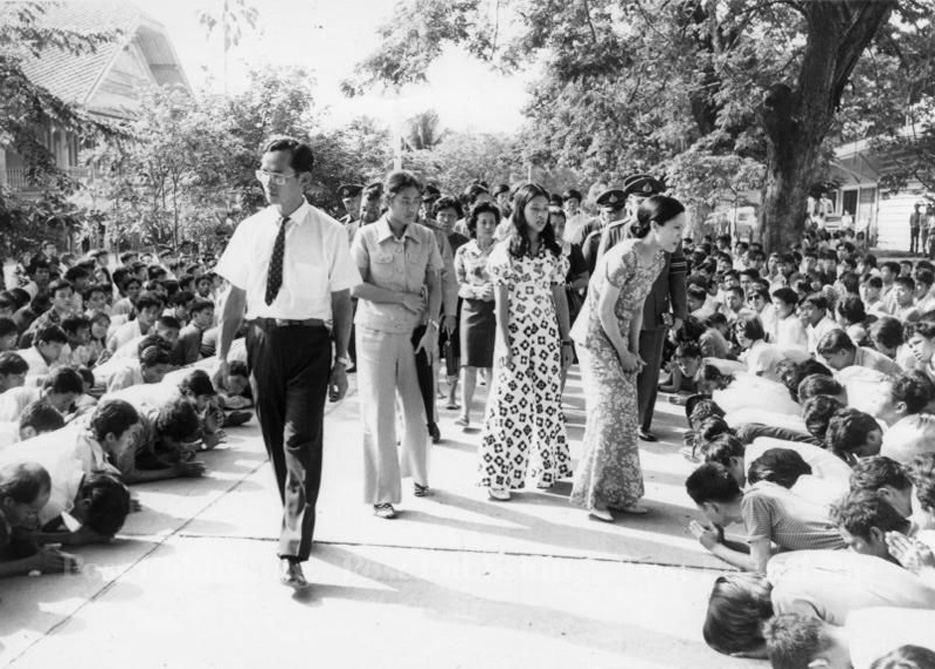
As the constitutional monarch, His Majesty the King stayed detached from politics while maintaining ‘’the right to be consulted, the right to encourage and the right to warn’’
With few exceptions, His Majesty maintained political neutrality.
“We keep in the middle, a neutral and peaceful co-existence with everybody. That the way to do it. We are in the middle,’’ His Majesty said during an interview with the BBC documentary entitled Soul of a Nation in 1979.
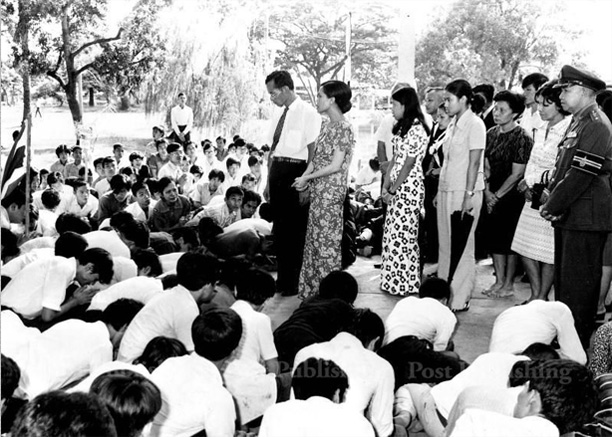
Thailand was embroiled in what was considered one of its worst political crises in modern history in the summer of 2006.
Protests were held almost daily mainly by middle-class urbanites under the banner of the People’s Alliance for Democracy (PAD), distinguished by its use of yellow-coloured shirts to identify its supporters.

Led by then media mogul Sondhi Limthongkul, the movement was against former prime minister Thaksin Shinawatra who despite winning a landslide election to form a single-party government for the first time in the country’s history was accused of being involved in corrupt practices and conflicts of interest while in government.
The PAD demanded parliament invoke Section 7 of the constitution to allow His Majesty to appoint a prime minister to replace Thaksin.
Meanwhile, Thaksin’s supporters in several provincial strongholds such as Chiang Mai, Chiang Rai, Udon Thani and Khon Kaen began their own counter-movements and rallies.
As the conflict mounted, Thaksin dissolved the House and the Election Commission called snap elections for April 2.
However, the election was boycotted by the Opposition, claiming it was too hasty.
As the country was gripped by political deadlock, His Majesty stepped in to provide a guiding light to defuse the crisi.
The King separately told judges of the Supreme and Administrative Court to explore all legal solutions to get the country out of what he described as a ‘’political mess’’.
His Majesty also rejected calls by anti-Thaksin supporters that a royally-appointed premier be named, pointing out such an appointment would be undemocratic.
“Please consult with the people who govern the country. Please consult with the Supreme Court, the Appeal Court, the Criminal Court and with the other courts. It will help the country to be governed by democratic rule. Do not wait for a royally-appointed prime minister because that would not be democratic,’’ His Majesty told the Supreme Court judges.
To the Administrative Court judges, His Majesty raised the legitimacy of the April 2 election.
“Another point is whether it was right to dissolve the House and call for snap elections within 30 days. If it was not the right decision, it must be corrected,’’ His Majesty said.
In response to His Majesty’s speeches, senior judges of the Constitution, Supreme Administrative and Supreme courts, met to discuss ‘’legal solutions’’ to the political crisis.
On May 8, the Constitution Court ruled the repositioning of polling booths by the Election Commission, compromising voter confidentiality, and the way the snap election was held in a hasty manner was unconstitutional.

The Court thus nullified the April 2 election.
His Majesty’s most memorable act of guiding the nation out of a political crisis is probably his intervention after a deadly clash between government forces and protesters during the Black May clashes in 1992.
The King’s words to the two main leaders of the rival groups, former prime minister Suchinda Kraprayoon and Maj Gen Chamlong Srimuang who were both seated at his feet, still resonate in the heart of Thais.
“Thailand does not belong to one or two people, but to everyone. We have to reach out to one another, not to be intent on confrontation. We have to solve the problem. It’s dangerous when we get carried away and treat one another with violence. We lose ourselves in the process. In the end, we often forget what got us into the fight in the first place. We only knew we had to win,’’ His Majesty said in a speech that was broadcast nationwide on May 20, 1992.
“Can there be a winner? Of course not. It’s very dangerous. There will be only losers. Everyone becomes a loser. Each side in the confrontation is a loser. And it’s the nation that loses the most,’’ the King said as he reminded the rival parties of the damage incurred to the country by political conflicts.
His Majesty ended his speech with a rhetorical question that is still quoted today: “What is the point of claiming a victory when the victor will be standing on a pile of debris?’’
The Black May incident was sparked by widespread public resentment against the appointment of Gen Suchinda Kraprayoon as prime minister. He had led a coup against the so-called “buffet cabinet’’ of Gen Chatichai Choonhavan in 1991 and promised not to take up any position in the government.
The backlash was led by former Bangkok governor Maj Gen Chamlong Srimuang and the Federation of Thai Students before being joined by Opposition parties including the Democrats, New Aspiration and Palang Dham parties.
Large demonstrations were held nightly around Sanam Luang and Ratchadamnoen Avenue from April through to early May, when the government started to bring in soldiers to take control of the situation.
The increasingly tense confrontation turned violent after a crowd of demonstrators tried to move from Sanam Luang to Government House. Clashes ensued between protesters and security forces. Maj Gen Chamlong was arrested. The Royal Hotel on Ratchadamnoen Avenue became a temporary first aid unit until it was stormed by government troops, as arsonists set fire to the nearby Public Relations Department, tax office and other government buildings.
The violence went on for two days. By May 19, the situation had descended into chaos, with HRH Crown Prince Maha Vajiralongkorn and HRH Princess Maha Chakri Sirindhorn interrupting official visits overseas to broadcast pleas for peace.
Finally, on May 20, His Majesty the King summoned PM Gen Suchinda and Maj Gen Chamlong to Chitralada Palace and gave them his now-famous advice.
About a week later, Gen Suchinda resigned from his position while Maj Gen Chamlong retreated to Kanchanaburi province where he started a school to groom future leaders. Former diplomat Anand Panyarachun was appointed the new prime minister.
The year 1973 marked another turning point in Thailand’s political history with a public uprising against the dictatorial regime of Field Marshal Thanom Kittikachorn.
Alleged abuses of power by the government and widespread sugar shortages spawned public discontent.
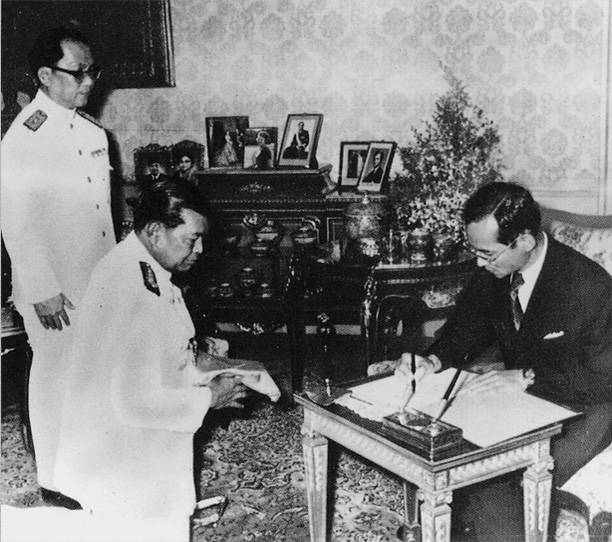
The situation came to a head on Oct 6 when police arrested 13 activists and student leaders for demanding a new constitution and return to democratic rule.
Demonstrations took place at Thammasat University to demand the release of those arrested. Before long, there were at least 400,000 students around the Democracy
Monument, carrying posters of Their Majesties the King and Queen.
PM Field Marshal Thanom sought an audience with His Majesty to brief him about the situation and to seek his advice. The King expressed his wish that the authorities refrain from the use of force and urged the government to seek a peaceful end to the conflict.
On Oct 13, the government submitted to the protesters’ demands. An agreement was drafted and signed by both parties.
In the early morning of Oct 14, however, as demonstrators were heading home, a fight broke out between them and police.
Police, who thought the retreating crowds were moving towards Chitralada Palace, used tear gas and batons to disperse them. In the melee many demonstrators were forced to flee towards the palace grounds.
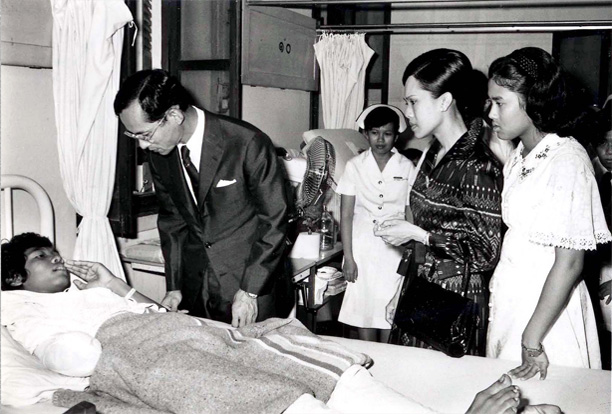
His Majesty not only instructed his guards to remove live ammunition from their weapons but also ordered the palace gates opened and allowed some 2,000 people to take shelter there.
At the same time, rumours spread the army and police had attacked and killed the demonstrators. Violence flared as protesters, many of them vocational students, fought back with makeshift weapons and set fire to government buildings and public buses.
The following day, Field Marshal Thanom, Field Marshal Praphas Charusathian (deputy PM and interior minister) and Col Narong Kittikachorn (Thanom’s son and Praphas’s son-in-law) resigned and left the country.
His Majesty appeared in a live television broadcast to assure the nation the crisis had subsided. The King also announced the appointment of his privy councillor Prof Sanya Dharmasakti as the new prime minister.
The state-sponsored crackdown on left-leaning students at Thammasat University at the dawn of Oct 6 which left more than 50 dead and over 100 injured is one of the darkest chapters in Thailand’s history.
As countries in Southeast Asia fell to communism in the 1970s, starting with Laos, then Cambodia and Vietnam, the Thai establishment was gripped by fear of the so-called “domino effect.’’
Leftist ideologies took hold among some groups of students, unionists and political activists. The rising political temperature found a trigger point after former PM Thanom Kittikachorn, forced to go into exile three years earlier following the Oct 14 uprising, sneaked back into the country.
Protests by the students and activists were met with right-wing propaganda and communist scaremongering that fanned the flames of hatred.
The conflict boiled over on Oct 5, after Thammasat University students held a protest by presenting a tableau of a mock-hanging of two trade unionists suspected of having been assassinated by police.
One of the ‘’actors’’, however, was accused by right-wing activists and media of bearing a resemblance to HRH Crown Prince Maha Vajiralongkorn.
As events threatened to get out of control, the then government of Seni Pramoj could not prevent a forthcoming confrontation and a crackdown on the student protesters finally occurred. Brutal killings and abuses followed resulting in more than 50 deaths.
The massacre was followed by a coup led by Admiral Sangad Chaloryu.
That evening, Admiral Sangad and army chief Gen Kriangsak Chamanan were granted an audience with His Majesty the King.
A list of three potential candidates for the premiership was submitted to the King for consultation. Two days later, Thanin Kraivixien, a Supreme Court Chief Justice, was appointed the new prime minister.
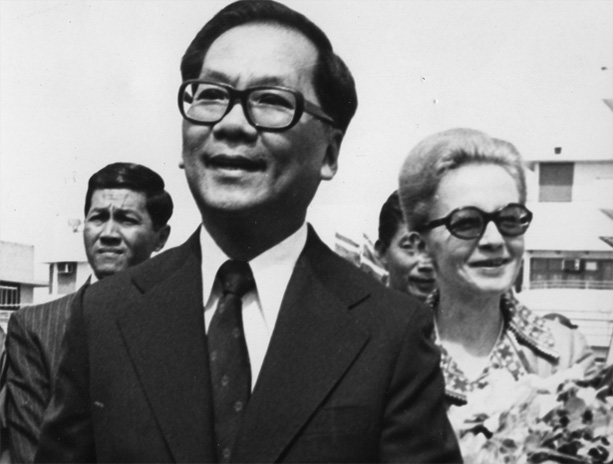
Disillusioned and crushed by the right wing, tens of thousands of students, farmers and unionists and activists joined the jungle-based communist movement and took up arms against the government. They would remain there for many years, until then army chief Gen Chavalit Yongchaiyudh came up with a proposal offering an amnesty to those who returned to the fold in 1980.